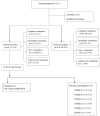Characterization of Rotavirus Infection in Hospitalized Children under 5 with Acute Gastroenteritis 5 Years after Introducing the Rotavirus Vaccines in South Korea
- PMID: 36360361
- PMCID: PMC9688952
- DOI: 10.3390/children9111633
Characterization of Rotavirus Infection in Hospitalized Children under 5 with Acute Gastroenteritis 5 Years after Introducing the Rotavirus Vaccines in South Korea
Abstract
We herein characterized rotavirus infection in hospitalized children under 5 years of age with gastroenteritis after introducing rotavirus vaccines in South Korea from 20 February 2012, to 31 March 2013. Enzyme-linked fluorescent immunoassay was performed to detect rotavirus antigens. G and P genotyping was performed using nested multiplex PCR. For the failed PCR samples, sequencing was conducted. We performed a test-negative case-control study to estimate vaccine effectiveness. Vaccine effectiveness was measured using a multivariate logistic regression model. Rotavirus was detected in 16 (13.2%) of the 121 patients, with a seasonal peak in April 2012. The dominant genotypes detected were G3P[8] (33.3%) and G4P[6] (26.7%), and vaccine effectiveness against rotavirus hospitalization was 84.9% [95% CI: 23.2−97.0] in the complete vaccinated group. A higher prevalence of rotavirus infection was observed among children with siblings than those without siblings (p < 0.001). Also, the presence of siblings was significantly associated with a history of nonvaccination (p < 0.001). In conclusion, the prevalence of rotavirus followed a decreasing trend, and there was no evidence of emergences of nonvaccine-type strains. Vaccine effectiveness against rotavirus hospitalization was 84.9%. Although children with siblings were more susceptible to rotavirus infection, they were less likely to receive vaccination against rotavirus.
Keywords: genotype; prevalence; rotavirus; siblings; vaccine; vaccine effectiveness.
Conflict of interest statement
The authors declare no conflict of interest.
Figures
References
-
- Troeger C., Blacker B.F., Khalil I.A., Rao P.C., Cao S., Zimsen S.R., Albertson S.B., Stanaway J.D., Deshpande A., Abebe Z., et al. Estimates of the Global, Regional, and National Morbidity, Mortality, and Aetiologies of Diarrhoea in 195 Countries: A Systematic Analysis for the Global Burden of Disease Study 2016. Lancet Infect. Dis. 2018;18:1211–1228. doi: 10.1016/S1473-3099(18)30362-1. - DOI - PMC - PubMed
-
- Kang J.O., Kilgore P., Kim J.S., Nyambat B., Kim J., Suh H.S., Yoon Y., Jang S., Chang C., Choi S., et al. Molecular Epidemiological Profile of Rotavirus in South Korea, July 2002 through June 2003: Emergence of G4P[6] and G9P[8] Strains. J. Infect. Dis. 2005;192:S57–S63. doi: 10.1086/431502. - DOI - PubMed
-
- Troeger C., Khalil I.A., Rao P.C., Cao S., Blacker B.F., Ahmed T., Armah G., Bines J.E., Brewer T.G., Colombara D.V., et al. Rotavirus Vaccination and the Global Burden of Rotavirus Diarrhea among Children Younger Than 5 Years. JAMA Pediatr. 2018;172:958–965. doi: 10.1001/jamapediatrics.2018.1960. - DOI - PMC - PubMed
Grants and funding
LinkOut - more resources
Full Text Sources
Miscellaneous




